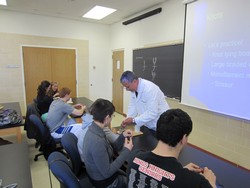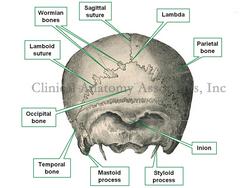
Medical Terminology Daily (MTD) is a blog sponsored by Clinical Anatomy Associates, Inc. as a service to the medical community. We post anatomical, medical or surgical terms, their meaning and usage, as well as biographical notes on anatomists, surgeons, and researchers through the ages. Be warned that some of the images used depict human anatomical specimens.
You are welcome to submit questions and suggestions using our "Contact Us" form. The information on this blog follows the terms on our "Privacy and Security Statement" and cannot be construed as medical guidance or instructions for treatment.
We have 1456 guests online

Georg Eduard Von Rindfleisch
(1836 – 1908)
German pathologist and histologist of Bavarian nobility ancestry. Rindfleisch studied medicine in Würzburg, Berlin, and Heidelberg, earning his MD in 1859 with the thesis “De Vasorum Genesi” (on the generation of vessels) under the tutelage of Rudolf Virchow (1821 - 1902). He then continued as a assistant to Virchow in a newly founded institute in Berlin. He then moved to Breslau in 1861 as an assistant to Rudolf Heidenhain (1834–1897), becoming a professor of pathological anatomy. In 1865 he became full professor in Bonn and in 1874 in Würzburg, where a new pathological institute was built according to his design (completed in 1878), where he worked until his retirement in 1906.
He was the first to describe the inflammatory background of multiple sclerosis in 1863, when he noted that demyelinated lesions have in their center small vessels that are surrounded by a leukocyte inflammatory infiltrate.
After extensive investigations, he suspected an infectious origin of tuberculosis - even before Robert Koch's detection of the tuberculosis bacillus in 1892. Rindfleisch 's special achievement is the description of the morphologically conspicuous macrophages in typhoid inflammation. His distinction between myocardial infarction and myocarditis in 1890 is also of lasting importance.
Associated eponyms
"Rindfleisch's folds": Usually a single semilunar fold of the serous surface of the pericardium around the origin of the aorta. Also known as the plica semilunaris aortæ.
"Rindfleisch's cells": Historical (and obsolete) name for eosinophilic leukocytes.
Personal note: G. Rindfleisch’s book “Traité D' Histologie Pathologique” 2nd edition (1873) is now part of my library. This book was translated from German to French by Dr. Frédéric Gross (1844-1927) , Associate Professor of the Medicine Faculty in Nancy, France. The book is dedicated to Dr. Theodore Billroth (1829-1894), an important surgeon whose pioneering work on subtotal gastrectomies paved the way for today’s robotic bariatric surgery. Dr. Miranda.
Sources:
1. "Stedmans Medical Eponyms" Forbis, P.; Bartolucci, SL; 1998 Williams and Wilkins
2. "Rindfleisch, Georg Eduard von (bayerischer Adel?)" Deutsche Biographie
3. "The pathology of multiple sclerosis and its evolution" Lassmann H. (1999) Philos Trans R Soc Lond B Biol Sci. 354 (1390): 1635–40.
4. “Traité D' Histologie Pathologique” G.E.
Rindfleisch 2nd Ed (1873) Ballieres et Fils. Paris, Translated by F Gross
"Clinical Anatomy Associates, Inc., and the contributors of "Medical Terminology Daily" wish to thank all individuals who donate their bodies and tissues for the advancement of education and research”.
Click here for more information
- Details
The prefix [eu-] is of Greek origin and means "good", or "well". It is found in medical and everyday terms as follow:
- Euphoria: The root term [-phor-] means "to bear", "to carry" or "oneself" Euphoria is "feeling good about oneself". The antonym would be "dysphoria"
- Euphonic:The root term [-phon-] means "sound", or "voice". To "sound good"
- Eugenic: Good genes
- Euthanasia: From the Greek word [θάνατος] (thanatos) meaning "death". A good death
- Eulogy: The root term [-log-] means "word". A "good word", a "good speech"
- Eunym: A good name
Note: The links to Google Translate include an icon that will allow you to hear the pronunciation of the word
- Details
The term [dysphoria] is composed of the prefix [dys-] meaning "abnormal, the root term [-phor-] meaning "to bear" or "to carry", and the suffix [-ia] meaning "condition" or "situation". The root term requires a little more explanation. Initially the term was used to denote "enduring", later "productive" or "fertile" and in modern medical terminology, the meaning of mental health, as in to "carry oneself" or "well-being".
Thus explained, dysphoria means "a condition of abnormal feeling about oneself". The term is used in depressive mood disorders and is characterized by anxiety, depression, sleeping disorder, etc.
The opposite of dysphoria is [euphoria] from the Greek suffix [eu-] meaning "good" or "well". Euphoria is "feeling good"
- Details
Wormian bones are small flat bones found within the suture joints of the cranium. They are also known as "intrasutural bones" (see image). These bones will vary in number and in size per individual, and are not rare to find.
These bones are eponymic, named after Olao Claus Worm Sr. (1588 - 1654), a Danish professor of Medicine and Physiology. Known by his Latinized name Olaus Wormius, he described the embryology of these bones. The eponym was created by his nephew Thomas Bartholin (1616 - 1680).
An interesting variation of a Wormian bone is the [Inca bone] also known as the Os Incae. This is an interparietal bone which can present many variations, its importance being that it can be misdiagnosed as a skull fracture, specially in children.
Sources:
1. "Interparietal bone: a case report"Mirsa, BD. J Anat Soc India (1960) 9; 39.
2. "Variations of the interparietal bone in man" Pal,GP J Anat (1987)152; 205-208.
3. "Radiological case of the month" Parente, K et al Arch Ped Adolesc Med (2001) 155;731-732
4. "The Origin of Medical Terms" Skinner, HA 1970 Hafner Publishing Co.
Article image in public domain, modified from Toldt's "Atlas of Human Anatomy", 1903
- Details

Click for the Facebook article
Today, instead of writing an article for this blog I prepared and delivered a lecture on "Surgical Sutures, Needles, and Knots" which included a short hands-on lab on knots and wound closure on simulated tissue.
This was presented at the request of the Pre-Health club of the College of Mount Saint Joseph in Cincinnati, OH. I am always glad to be invited to do these presentations as they allow me to maintain contact with the future generation of Health Care Professionals.
Of course this is a very short presentation compared to the longer course that Clinical Anatomy Associates, Inc. delivers for medical companies, but it shows these future professionals the complexity of the world of wound closure, healing, surgical sutures, needles, and knots.
We ended the lab with the challenge to do a two-layer closure of a simulated wound. Most of the attendees did a pretty good job. Congratulations!
My personal thanks to Dr. Eric Johnson who coordinated the meeting, and to the Pre-Health Club for their invitation. For more pictures of the meeting, see the Facebook album page of "Medical Terminology Daily"
- Details
The root term [-rachi-] comes from the Greek word [?άχις] (rhakhis) and means "a spine" or "a ridge". It is used to denote the spinal or vertebral column. This root term is used in many sciences such as botany, zoology, comparative anatomy, etc. Some of these uses can be read here.
The plural for is rachides. Examples of its use in human anatomy and pathology are:
• Rachitic: An individual with spine pathology. A patient with cachexia so severe that the spine is clearly seen
• Rachischisis: A congenital separation or cleft usually found in the lower portion of the spinal colum
- Details
The suffix [-schisis-] comes from the Greek word [σχίσις] and means "to tear" or "to separate". In Medicine today its meaning is that of "a cleft", a "split", or "a separation".
Examples of its use are:
- Palatoschisis: A cleft or separation of the palate, also known as uranoschisis
- Cheilognathopalatoschisis: This word combines several roots: [-cheil-], meaning "lip", [-gnath-] meaning "jaw", [-palat-], meaning "palate", while the suffix [-schisis] means "to split". A split or separation of the lip, jaw, and the hard and soft palate.
- Cranioschisis: A congenital cleft in the cranium
- Rachischisis: A congenital separation or cleft usually found in the lower portion of the spinal column
- Gastroschisis: A congenital condition where the abdominal wall does not complete its normal closure and the baby is born with an incomplete abdominal wall allowing for the extrusion of abdominal viscera usually in a right paraumbilical position


